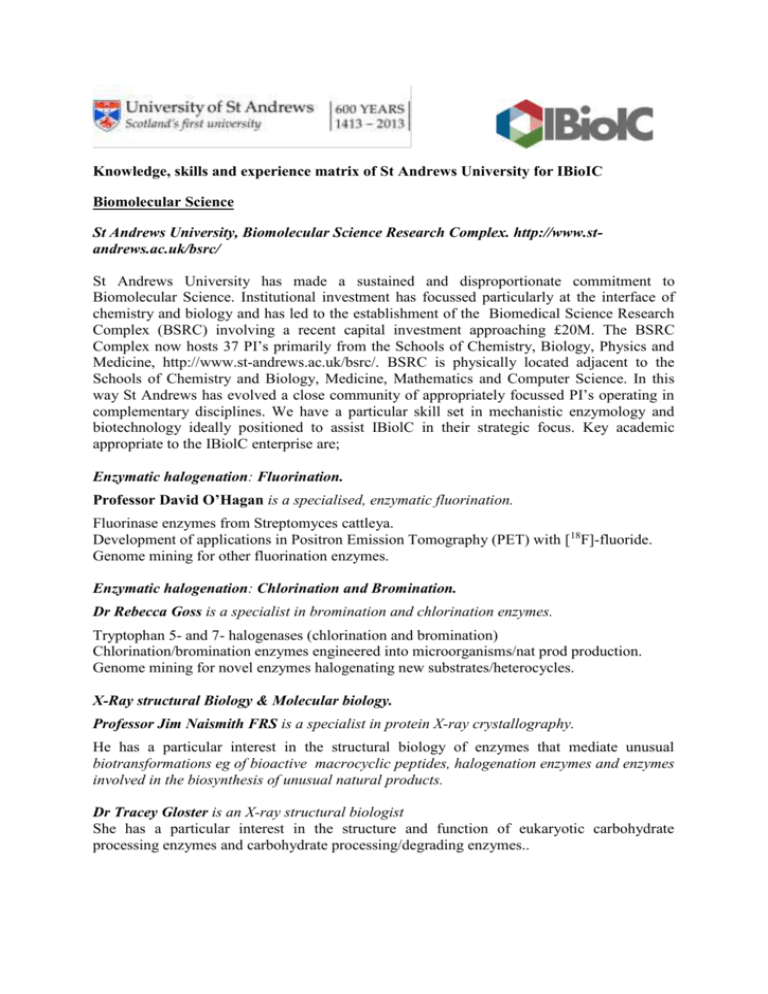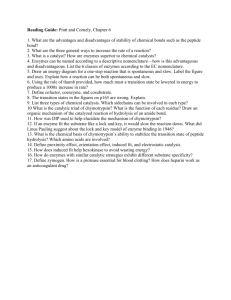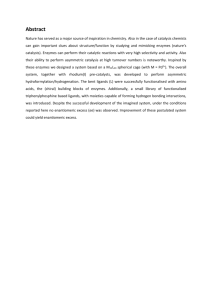Knowledge, skills and experience matrix of St Andrews University for
advertisement

Knowledge, skills and experience matrix of St Andrews University for IBioIC Biomolecular Science St Andrews University, Biomolecular Science Research Complex. http://www.standrews.ac.uk/bsrc/ St Andrews University has made a sustained and disproportionate commitment to Biomolecular Science. Institutional investment has focussed particularly at the interface of chemistry and biology and has led to the establishment of the Biomedical Science Research Complex (BSRC) involving a recent capital investment approaching £20M. The BSRC Complex now hosts 37 PI’s primarily from the Schools of Chemistry, Biology, Physics and Medicine, http://www.st-andrews.ac.uk/bsrc/. BSRC is physically located adjacent to the Schools of Chemistry and Biology, Medicine, Mathematics and Computer Science. In this way St Andrews has evolved a close community of appropriately focussed PI’s operating in complementary disciplines. We have a particular skill set in mechanistic enzymology and biotechnology ideally positioned to assist IBiolC in their strategic focus. Key academic appropriate to the IBiolC enterprise are; Enzymatic halogenation: Fluorination. Professor David O’Hagan is a specialised, enzymatic fluorination. Fluorinase enzymes from Streptomyces cattleya. Development of applications in Positron Emission Tomography (PET) with [18F]-fluoride. Genome mining for other fluorination enzymes. Enzymatic halogenation: Chlorination and Bromination. Dr Rebecca Goss is a specialist in bromination and chlorination enzymes. Tryptophan 5- and 7- halogenases (chlorination and bromination) Chlorination/bromination enzymes engineered into microorganisms/nat prod production. Genome mining for novel enzymes halogenating new substrates/heterocycles. X-Ray structural Biology & Molecular biology. Professor Jim Naismith FRS is a specialist in protein X-ray crystallography. He has a particular interest in the structural biology of enzymes that mediate unusual biotransformations eg of bioactive macrocyclic peptides, halogenation enzymes and enzymes involved in the biosynthesis of unusual natural products. Dr Tracey Gloster is an X-ray structural biologist She has a particular interest in the structure and function of eukaryotic carbohydrate processing enzymes and carbohydrate processing/degrading enzymes.. Biocatalysis Efficient use of Biomass (Bio)catalytic conversions of (renewable) feedstocks [Contact: Prof Paul Kamer pcjk@stand.ac.uk] The catalysis team in St Andrews investigates the catalytic conversion of both traditional feedstocks from fossil reserves and renewable resources obtained from biomass. The research focuses on the field of homogeneous catalysis with the aid of transition metal complexes and a broad range of catalytic reactions has been studied. The major activity is in the field of ligand synthesis based on phosphorus donor atoms by rational design assisted by molecular modelling. Ligand design is supported by mechanistic (in-situ) studies of catalytic reactions to acquire insight into structure-activity relations. For example, catalytic reactions can be accelerated by forcing the geometry of the “catalyst” towards a structure that resembles the transition state, as has been proposed for metalloenzymes. This has resulted in the development of novel catalytic systems including artificial metalloenzymes based on phosphorus donor ligands and artificial nitrogen donor based cofactors. The biomass conversion focuses on mild catalytic degradation of lignin for the production of high value chemical feedstocks. Downstream processing for the production of fine chemicals is explored using all available catalytic tools including homogeneous, bio- and organocatalysis. Selective Modification and structural analysis of Lignin [Contact: Prof Nick Westwood njw3@st-and.ac.uk] The Chemical Biology and Natural Product Synthesis team has first-hand experience of the medium- to high-throughput synthesis of compound collections. They have established a laboratory within EaStCHEM that can support the semi-automated synthesis of bioactive compounds and catalyst ligands. There is a large interest in natural product synthesis and catalysis. The research presently focuses on the selective oxidative degradation of lignin for the production of aromatic compounds. The team is developing advanced NMR methods for structural analysis of complex biopolymers such as lignin. Specific linkages are identified and catalytic conversions are monitored enabling fast catalyst optimization. Overview of Industrial Biocatalytic Processes and Fundamentals of Molecular Biology [Contact: Dr Tracey Gloster tmg@st-andrews.ac.uk and Prof. Nick Westwood njw3@standrews.ac.uk] As part of the recently funded CDT in critical resources catalysis (http://www.criticat.org/index.php) a series of lectures involving an introduction to the role of biocatalysis in Industry and fundamental aspects of molecular biology and biocatalysis are being developed. Any part of this series of 9-12 lectures could be delivered in support of an IBioIC programme. Bioenergy Energy Materials Professor John Irvine leads a group of 50 researchers specialising in Energy Materials. Their activities include a number of programmes relating to bioenergy. Direct Carbon Fuel Cells – High efficiency conversion of a wide variety of biochars to electricity (EU) Photocatalysis assisted conversion of cellulose to ethanol in collaboration with Robert Gordon University (Lawton, Robertson) (EPSRC) Steam reforming of biofuels (glycerol, ethanol) Biogas utilisation in fuel cells (UK/India EPSRC) Biodiesel production via heterogeneous catalysis Upgrade of biogas via electrolysis









